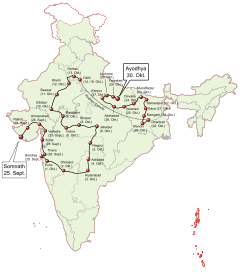 The planned route of L. K. Advani's Rath Yatra, beginning in Somnath on 25 September 1990 and ending in Ayodhya on 30 October | |
| Date | 25 September – 30 October 1990 |
|---|---|
The Ram Rath Yatra was a political and religious rally that lasted from September to October 1990. It was organised by the Bharatiya Janata Party (BJP) and its Hindu nationalist affiliates, and led by the then-president of the BJP, L. K. Advani. The purpose of the yatra was to support the agitation, led by the Vishwa Hindu Parishad (VHP) and its affiliates in the Sangh Parivar, to erect a temple to the Hindu deity Rama on the site of the Babri Masjid.[1]
The masjid, or mosque, had been built in the city of Ayodhya following the Mughal conquest of the region in 1528. According to hearsay, it was built over a temple dedicated to Rama, and stood on the site of his birth. In the 1980s, the VHP and other Sangh Parivar affiliates began an agitation to build a temple to Rama at the site, with the BJP lending political support to the movement. In 1990, the government of India led by V. P. Singh decided to implement some of the recommendations of the Mandal commission, and announced that twenty-seven percent of government jobs would be reserved for people from Other Backward Class. This announcement threatened the electoral constituency of the BJP, which decided to use the Ayodhya dispute to unite the Hindu vote by mobilising anti-Muslim sentiment.[1]
In order to further this movement, the BJP announced a rath yatra, or "chariot journey" across the country to Ayodhya. The procession was led by L. K. Advani, and involved thousands of kar sevaks, or volunteers, from the Sangh Parivar. The yatra began in Somnath on 25 September 1990, and passed through hundreds of villages and cities. It traveled approximately 300 kilometers a day, and Advani often addressed six public rallies in a single day. The yatra caused an outpouring of both religious and militant sentiments among Hindus, and became one of the biggest and greatest mass movements in Indian history.[1]
The yatra also triggered religious violence in its wake, with riots in cities across North India. As a result, Advani was arrested by the government of Bihar as the yatra passed through that state, and 150,000 of his supporters were also arrested by the government of Uttar Pradesh. Tens of thousands of activists nonetheless reached Ayodhya and attempted to storm the mosque, resulting in a pitched battle with security forces which left 20 dead. These events caused further Hindu-Muslim riots to break out across the country, in which hundreds were killed.[2] Muslims were often the victims of these riots, particularly in the state of Uttar Pradesh. Following these riots, the BJP withdrew its support to the Union government, leading to early parliamentary elections. The BJP made significant gains in these elections, both at the national and the state level, on the back of religious polarisation caused by the yatra.
- ^ a b c Jaffrelot 2009.
- ^ Srinivas 1991.
